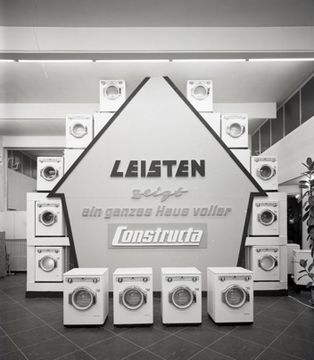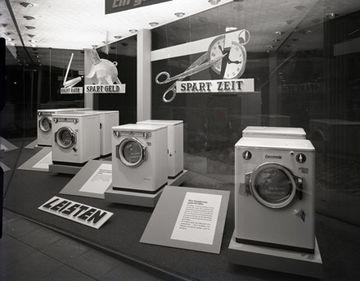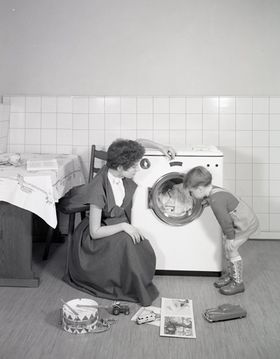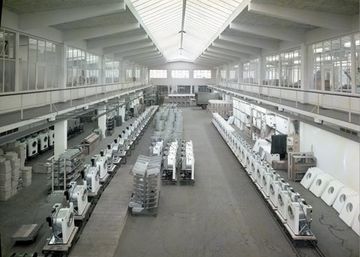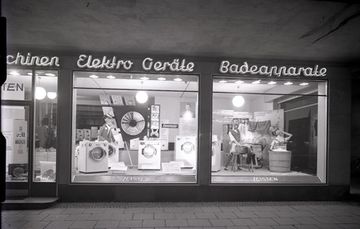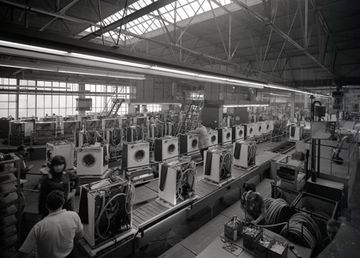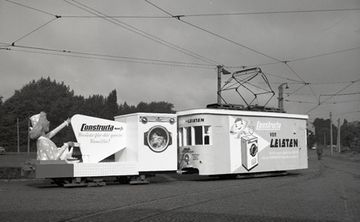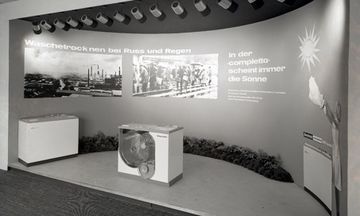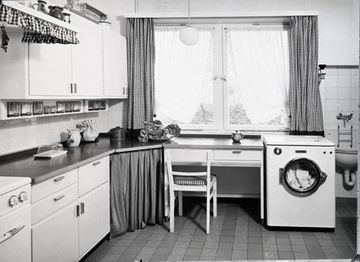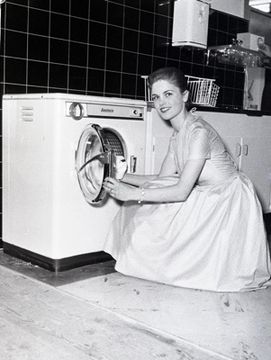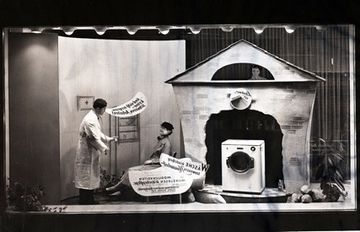Constructa - eine Waschmaschinen-Legende/en: Unterschied zwischen den Versionen
Zur Navigation springen
Zur Suche springen
(Die Seite wurde neu angelegt: „alt=Picture of the follow-up model of the first Constructa fully automatic wasching machine in the BSH wiki|thumb|The follow-up model of the first Constructa fully automatic wasching machine, 1950s. (Source: BSH Corporate Archives) Engineering company Peter Pfenningsberg GmbH from Düsseldorf launched Germany's first fully automatic washing machine on the market in 1951. The machine was stil…“) |
Keine Bearbeitungszusammenfassung |
||
| Zeile 1: | Zeile 1: | ||
<languages/> | <languages/> | ||
In the 1950s, the Constructa was the first washing machine manufactured in Germany, representing a breakthrough for the manufacturer Constructa Werke GmbH. With an 80 percent market share, the company was still the clear leader among washing machine producers in Germany even 20 years on. Constructa was taken over by Siemens in 1961 and thus became an integral part of BSH in 1967. | |||
<br> | |||
<br> | |||
<gallery mode="traditional" perrow=2 widths=360 px heights= 360 px> | |||
file: Unbenannt_1.jpg|<br>“An entire house full of Constructa.” The “Constructa,” developed by engineer Peter Pfenningsberg from Mettmann, sold like hotcakes in the 1950s (Source: BSH Corporate Archives) <br> <br> | |||
file: Unbenannt_2.jpg|<br>“Saves time, saves money, saves space.” The Constructa was a revolution for German households. (Source: BSH Corporate Archives) <br> <br> | |||
file: Unbenannt_3.jpg|<br>The porthole was the trademark of the “Constructa” – the round glass door on the front for loading the appliance (Source: BSH Corporate Archives)<br> <br> | |||
file: Unbenannt_4.jpg|<br>Not only is the washing clean – the production hall at Constructa Werke GmbH is also spick and span. (Source: BSH Corporate Archives) <br> <br> | |||
file: Unbenannt_5.jpg|<br> Windowshopping with Constructa <br> <br> | |||
file: Unbenannt_6.jpg|<br> The first German automatic washing machines were initially still produced in small volumes of ten appliances per day. In the 1950s, production increased tenfold. (Source: BSH Corporate Archives) <br> <br> | |||
file: Unbenannt_7.jpg|<br> The massive increase in production was accompanied by a variety of creative advertising campaigns to increase demand for the relatively new and unknown product. (Source: BSH Corporate Archives) <br> <br> | |||
file: Unbenannt_8.jpg|<br> 140 VW Beetles. The Constructa Werke GmbH fleet. (Source: BSH Corporate Archives) <br> <br> | |||
file: Unbenannt_9.jpg|<br> The appliance got its name from the Constructa trade fair in Hanover where Peter Pfenningsberg presented his washing machine for the first time. (Source: BSH Corporate Archives) <br> <br> | |||
file: Unbenannt_10.jpg|<br> A revolutionary feature of the first Constructa machines was that a hot water connection was no longer needed. (Source: BSH Corporate Archives) <br> <br> | |||
file: Unbenannt_11.jpg|<br> Competition became increasingly intense following the economic miracle. Products from Italian manufacturers provided particularly fierce competition. (Source: BSH Corporate Archives) <br> <br> | |||
file: Unbenannt_12.jpg|<br> Stealing the show. The Constructa on stage. (Source: BSH Corporate Archives) <br> <br> | |||
</gallery> | |||
Version vom 24. Juli 2023, 12:52 Uhr
In the 1950s, the Constructa was the first washing machine manufactured in Germany, representing a breakthrough for the manufacturer Constructa Werke GmbH. With an 80 percent market share, the company was still the clear leader among washing machine producers in Germany even 20 years on. Constructa was taken over by Siemens in 1961 and thus became an integral part of BSH in 1967.
